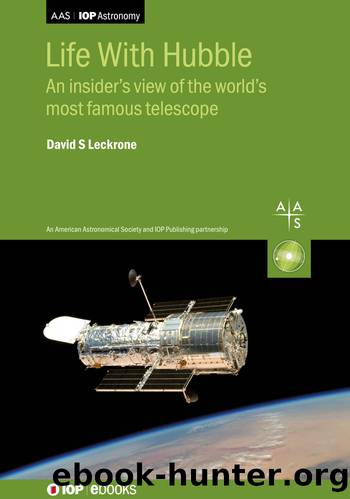Life With Hubble: An insider’s view of the world’s most famous telescope by David S Leckrone

Author:David S Leckrone
Language: eng
Format: epub
ISBN: 9780750320382
Publisher: IOP Publishing
Published: 2020-06-29T00:00:00+00:00
Lead EVA astronaut, Mark Lee, and his partner, Steve Smith, fully suited up, were in the airlock following the procedure to depressurize—to expel the air from the airlock out into space. The only concern the crew noted was that the rate of depressurization was a little faster than expected. Otherwise all seemed normal.
Then, suddenly, we lost much of the telemetry from the telescope, as seen both at Goddard and by all of us at JSC. Hubble had shut down. We didn’t know why. “What the hell happened?,” John Campbell exclaimed. The Shuttle Flight Director in the Mission Control Room got on the loop and asked the Hubble team, “Did you guys do anything?” A chaotic din of conversations began within the HST team, both face-to-face and on the communications links. Campbell got on the “all HST” channel that the entire team would be monitoring and said, “Calm down everybody. Let’s take some time and figure out what happened.”
About a half hour went by, but it seemed longer than that. Then the astronauts said they had seen one of the solar arrays move, but they didn’t know why. When they first noticed the movement, the solar array closest to the crew cabin was spinning. It passed through 45° from horizontal, then to 90° (parallel to HST’s long axis), then over to 30° from horizontal on the other side and finally rebounded slowly back to about 45°, ending up a full 135° from where it was supposed to be. The crew estimated that the movement took about 15 s all together.
The STOCC had enough basic telemetry from the spacecraft to verify that the two solar array wings were now mismatched; they were no longer aligned as they should be, parallel to each other and perpendicular to the long axis of the telescope. One wing was correctly oriented, but the other was not. When the spacecraft’s DF224 computer detected that the two array wings were misaligned, it automatically put Hubble into a safe mode. That’s why, suddenly, we were not receiving normal telemetry.
Because the Hubble solar arrays were off-kilter, the JSC shuttle guys became concerned. After all, if our telescope’s arrays were mismatched, we must have done something wrong, issued an errant command or something. That was their working assumption.
It was Cepi’s team that first came up with the correct answer. Engineers on console in the CSR, Rud Moe and Mike Weiss, pointed out that we were dealing with a new airlock, and the event happened while it was being depressurized. The plume of air flowing out from the airlock might have hit that array wing, forcing it into an un-commanded rotation.
Lee and Smith waited in the airlock while the solar array anomaly was being assessed. The crew inside the shuttle cabin was discussing the situation further with Mission Control. They said, “We all agree here that the movement and even the dampening oscillations [when the rotation stopped] were more a movement of the canister [the central cylinder from which the arrays were
Download
This site does not store any files on its server. We only index and link to content provided by other sites. Please contact the content providers to delete copyright contents if any and email us, we'll remove relevant links or contents immediately.
Tools of Titans by Timothy Ferriss(7811)
Turbulence by E. J. Noyes(7700)
Astrophysics for People in a Hurry by Neil DeGrasse Tyson(5000)
Secrets of Antigravity Propulsion: Tesla, UFOs, and Classified Aerospace Technology by Ph.D. Paul A. Laviolette(4990)
Design of Trajectory Optimization Approach for Space Maneuver Vehicle Skip Entry Problems by Runqi Chai & Al Savvaris & Antonios Tsourdos & Senchun Chai(4839)
Room 212 by Kate Stewart(4733)
Pale Blue Dot by Carl Sagan(4613)
The David Icke Guide to the Global Conspiracy (and how to end it) by David Icke(4379)
A Journey Through Divination and Astronomy by Publishing Pottermore(4248)
Apollo 8 by Jeffrey Kluger(3512)
Goodbye Paradise(3444)
Losing the Nobel Prize by Brian Keating(3425)
COSMOS by Carl Sagan(3346)
The Five People You Meet in Heaven by Mitch Albom(3334)
How to Read Water: Clues and Patterns from Puddles to the Sea (Natural Navigation) by Tristan Gooley(3239)
Brief Answers to the Big Questions by Stephen Hawking(3239)
How to Read Nature by Tristan Gooley(3077)
The Order of Time by Carlo Rovelli(3073)
A Brief History of Time by Stephen Hawking(2819)
